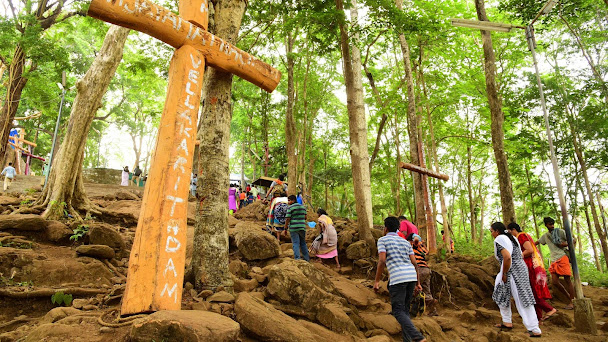Kadalur Lighthouse: The century old beacon along the land on Panthalayani Coast.
Standing tall at over 34 meters banded with white and black colors, the Kadalur Lighthouse at Thikkodi is a heritage of over a century. Built in 1908, this landside lighthouse is a place to visit for history enthusiasts and common folk alike.
The lighthouse in typical architecture was built by the British and commissioned in 1909 when the Chance Brothers 2nd order Dioptric revolving lens was installed with a white flashing light that could be seen for 20 miles. The lighthouse with 246 plastered and 15 steep wooden steps opens to a panoramic watch area which gives you the view of the sea on one side and the wide landscape of the Nandi area on the other side.
The lighthouse is in Thikkodi and has many names - Kadalur point, Cotta point, Nandi lighthouse. The word Cotta comes from Fort point which denotes the bastion point of the fort built by Mysore king Tipu Sultan in the 18th century as he always feared that his position could be compromised if the British attacked from the sea. This made him build a fort along the sea along the Kadalur coast. The fort was completely destroyed and many parts also fell into the sea when the sea receded. The lighthouse also stands at a place where there have been many ship wrecks and the last ship which met its fate was also during its construction called Ganesh Prasad sailing from Beypore to Cannanore.
The story of the Kadalur Lighthouse is incomplete without the mention of Velliyamkallu or Sacrificial rock which was what the British called the place. This rock formation is 8km away from the lighthouse point but due to its presence in the middle of the sea it is an obstruction for ships along the bay from Kappad to Mumbai. When the Arabs and Chinese traded with the Malabar coast, Panthalayani (Koyilandy) was the port they preferred. When the Portuguese & Dutch came to the shores in the later centuries this rock formation in the sea became a good hideout for local pirates who would attack the merchant ships from the rocks and the plundered goods would be distributed on the rocks. This large rock formation was not just a place of advantage for the pirates but also migratory birds who would flock to the rocks and their droppings over these rocks gave a white hue giving it the name Vellyamkallu (rocks with white color). When the British ships started wading these waters, they fought with the pirates and the prisoners caught by the pirates would be taken to the rocks for beheading. The British thus called this Sacrificial rock and gave out calls to avoid the route to travelling ships.
The presence of these rocks near the coast and the crescent shape of the area was also the reason why the British planned to build a lighthouse to warn ships. After taking control of the Malabar region following the Anglo Mysore war, the British made Thalassery their bastion and traded from Panthalayani. It was in 1895 that the need for the Lighthouse at Kadalur was proposed and the initial work was entrusted to FW Ashpitel who drew plans to make a sea washed lighthouse on the Sacrificial rock. This plan was not approved by the Madras Collector citing difficulties of construction, cost of maintenance, provisioning of keepers, constant change of guard and use of steamers for conveyance. The lighthouse thus got stuck in red tape for years until it was recommissioned in 1904. The final decision was made under the Coast light dues bill passed in 1904 to build the lighthouse on Cotta point and the construction of the structure was assigned to Captain Smith who started the work in December of 1907. The 34 metre tall structure was built with wire cut bricks from the Basel factory and the lantern room has 22 smooth steep stairs made with teak wood. The elevation of the lighthouse gave it a reach of around 27 nautical miles. By September 1908 the lighthouse structure was completed but it could not be put to use until the beam was placed and Trinity House, who were the authority for controlling all British lights had to be called in for expert opinion as to which type of lighthouse optic to be installed. The final decision was to use the Chance Incandescent Oil burners which had to be procured from Britain and again installation took time, it was only in October 1909 that the first beam was projected to officially commission the lighthouse.
The first light keeper was the eldest member of the family that helped Captain Smith with the construction and the members of the family continued to be head light keepers for another 4 generations until the union government nominated official light keepers.
Today the lighthouse stands tall even after a century amidst a thick coconut grove and giving out beams for not port of call but for peaceful navigation along the famed crescent coast. A valuable part of maritime history along the Malabar coast indeed !!
** The information of its construction is taken from the essays published in calicutheritage website.




Comments
Post a Comment